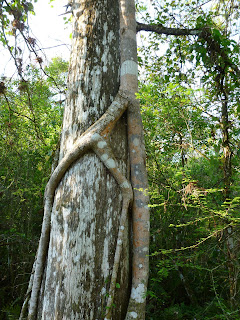43: Ferson Creek Fen. Dear Kane County, your parks and preserves are very nicely groomed, in that they have good signage, well-kept trails, and immaculate parking lots. However, when one is situated so far away from civilization, it would be helpful to include even the most primitive of bathroom facilities, especially when your vegetation is too sparse to provide adequate cover for outdoor peeing. It was a long drive out there, and I could not fully enjoy your preserve due to mounting pressure on internal organs. Just a thought for the future.
FCF is a rather small preserve, the fen/marsh area walkable in a short time. There is also allegedly a prairie trail, which I didn't explore because the literature doesn't make it sound like the showcase area of the site. And there were more pressing matters on my mind, pun intended. Near the first overlook platform, I was greeted by this ominous gatekeeper:
The poor little guy was shuddering and heaving with every breath, obviously in its final death throes. I finally passed by it when I determined it was too feeble to launch itself at me in a rabid fury. When I passed by it again on my way out of the overlook, it was too weak to even raise its head; it just rolled its head around on the ground and followed me with its horrible, sad, very human-like eyes. Then I spent the next ten minutes choking back tears, probably not a reasonable response to the impending death of something most people consider vermin. On to the botany!
The area to which the preserve map referred as the fen didn't appear to have any of the characteristic alkaline-loving fenny species touted by the INPC guide--turtlehead, grass-of-parnassus, Kalm's lobelia, etc. I squished around in it for awhile, but all I could find were some nice quality marsh species, like the marsh skullcap above, and the marsh bellflower below:
It also had a nice thick mat of marsh shield fern, and some common species like Eupatorium maculatum and Verbena hastata. Maybe I didn't squish around long enough or far enough to find the typical fen species. Then there came an area along the trail populated almost exclusively by Sagittaria latifolia and this stumper:
A Hypericum, obviously. It had fairly weak stems and formed a thick mat. It doesn't appear to be any of the Hypericums listed in the Kane Co. plant guide. Going through the Swink & Wilhelm key, it has more than 20 stamens (right?), petals solid yellow, plant herbaceous (not distinctly shrubby), flowers less than 3cm across, and I'm pretty sure the sepals were flat. That brings you to H. sphaerocarpum, which does not have an official record in Kane County (although almost every other county in IL has it). Did I find a new county record?
Then there was this species, which looked like nothing I knew. For the first time in ages, I had to go through the entire S&W key, because I couldn't place this to genus or even family, and I hadn't brought Newcomb with me (or Kane County Wild Plants & Natural Areas, doh!). Ah, yes. Justicia americana, water willow. Which I HAVE seen before, but very long ago. There was quite a healthy stand of this lining the banks of the Fox River. The damselflies were getting a kick out of it.
Circling back toward the parking lot, I took the boardwalk through what might have been a nice marsh in the days of yore, but is now a cattail desert. The only thing that will save that part of the site from certain doom is a good aerial nuking with herbicide. Or several.
Final verdict: Some nice spots, but definitely in need of some lovin'. Celebrity species are either kaput, dormant, or hiding in hard-to-reach nooks. Problem species: cattail, RCG, purple loosestrife, glossy buckthorn. An OK place to visit, but maybe not worth the trek from the city (unless you're on a quixotic quest to conquer all of the IL nature preserves, like some loonies who shall remain nameless).


























































